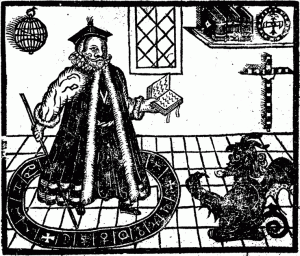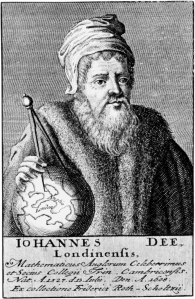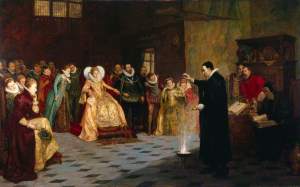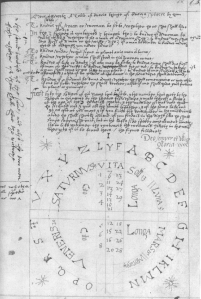An Introduction to Renaissance Occultism
“Magic comprises the most profound contemplation of the most secret things, their nature, power, quality, substance, and virtues, as well as the knowledge of their whole nature.” — Heinrich Cornelius Agrippa von Nettesheim, 1533

This woodcut from late (1620) edition of Marlowe’s famous play depicts Dr. Faustus summoning the Devil from his magic circle, wearing common symbols of Renaissance magic: a hat, cloak, and staff.
Although Renaissance (the late 15th to early 17th century in England; it began about 100 years earlier elsewhere) literally means ‘rebirth,’ it was very much a period of nostalgia, a return to the classics–art, literature, philosophy, and magic. Resurgence in occultism during the Renaissance occurred because of a massive discovery of medieval magical manuscripts and occult books.
The line between science and magic was blurred, almost interchangeable; a magus was an expert on any number of subjects, including all the tenants of the liberal arts (the trivium–grammar, logic and rhetoric–and the quadrivium– arithmetic, geometry, music, and astronomy). They believed that there was one essential path to truth, that with scholarly investigation and practice, humans could crack the code of the universe and come closer to God’s divinity.
There were two main categories of “high magic”–that is, occultism practiced by men who were capable of engaging in serious multidisciplinary study, as opposed to street magicians who did not have access to magic books: “Black magic,” or goety which included witches, demonologists and necromancers; and “white magic,” or theurgy, magic aimed toward discovering God’s secrets through the study of nature.
Overarching characteristics of the Renaissance magus include:
- Isolationism: In order for a successful magus to perfect his work, he needed to exercise total devotion to the craft. Magi often secluded themselves from the general population, pursuing their work in lavish personal libraries and workshops.
- Elitism: Antique magical manuscripts were rare, as were books in general. Only the elite few who were literate (in multiple languages) had access to these texts were capable of pursuing magic–by extension, successful magi were typically members of the aristocracy.
- Pride: The entire philosophy of Renaissance occultism–that man could unlock God’s secrets by studying his creations—necessitated a certain degree of vanity. This, combined with the magus’ constant need to defend his art from critics, earned him the reputation of being prideful and vain, even to the point of challenging God’s natural order of the universe.
Magic was also a popular form of entertainment, and The Tempest was part of a long tradition of depicting mysticism onstage. Immense public interest in occultism inspired various dramatists to weave their own perceptions of the craft into their plays. Shakespeare would have especially familiar with the works of contemporary playwrights Christopher Marlowe and Ben Jonson. Marlowe’s Doctor Faustus (1592) was a German legend retold as an English tragedy, a battle between good and evil in which the titular Faustus sells his soul to the devil to acquire magical powers. Jonson’s The Alchemist (1610) was a satirical commentary on occultism, depicting a fraud magician and the comedic effects of his selfish enterprise. These works, while very different in tone and style, both condemned magi as elitist and self-centered, and were reflective of the sceptical perception of occultism that many held at the time.
Opposition and Decline
“Alchemists grow old and die in the embraces of their illusion…the achievements of the magicians are unsure and fruitless. Those practices are openly convicted of vanity, and the secret and remotest loft tower’ of the magician’s pride must be abandoned if he is to come ‘close to things.’ The real truth is that the obstacle to the course I propose lies…in human pride…it is this pride that has brought men to such a pitch of madness that they prefer to commune with their own spirits rather than with the spirit of nature.” – Frances Bacon
Although magicians claimed they were working within the Christian doctrine, they natural faced opposition on the grounds that they were committing blasphemy. Some of the major characteristics of prominent magi worked against them. Despite support from Elizabeth I, herself a scholar and deeply curious mind, many members of the church criticized occultists for defying God’s natural order of and usurping Christian divinity. Before James I ascended the throne in 1603, he had already begun his active persecution against witchcraft and sorcery–in his eyes, there was no difference between white and black magic:
“At the first face appearing lawfull unto them, in respect the ground thereof seemeth to proceed of naturall causes onelie; they are so allured thereby, finding their practize to prove true in sundry things, they studie to now the cause thereof: and so mounting from degree to degree, upon the slipperie and uncertaine scale of curiositie; they are at last entised, that were lawfull arts or sciences failes, to satisfied their restless mindes, even to seeke that black and unlawfull science of Magic. — Daemonologie, James I
James’ persecution of witches and magi resulted in the near eradication of occultism in the mid 16th century. Most magi denounced their practice or denied any connection to it—with the notable exception of Dr. John Dee.
Dr. John Dee: A Case Study for Prospero
 Although Shakespeare was probably familiar with various famous magi, Dr. John Dee provides the most direct parallels to Prospero, and many scholars believe he was a model for the character to some degree. Prospero would certainly have been identified by audiences as a white magus (especially in comparison to Sycorax, a practice of black magic); even his physical appearance, the possession of a magic robe and staff, reflected early modern depictions of magi. Dee, in comparison, was described as “tall and slender. He wore a gown like an artist’s gown, with hanging sleeves, and a slit…. A very fair, clear sanguine complexion… a long beard as white as milk.”
Although Shakespeare was probably familiar with various famous magi, Dr. John Dee provides the most direct parallels to Prospero, and many scholars believe he was a model for the character to some degree. Prospero would certainly have been identified by audiences as a white magus (especially in comparison to Sycorax, a practice of black magic); even his physical appearance, the possession of a magic robe and staff, reflected early modern depictions of magi. Dee, in comparison, was described as “tall and slender. He wore a gown like an artist’s gown, with hanging sleeves, and a slit…. A very fair, clear sanguine complexion… a long beard as white as milk.”
Born in 1527, of Welsh ancestry and said to be a descendant of the ancient kings of Britain, Dee rose quickly to prominence because of his wholehearted dedication to knowledge from an early age. A brilliant mathematician, he travelled throughout Europe and was offered the Chair of Mathematics at the University of Paris at the age of 23 (which he declined). On his return to England he was appointed astrologer to Queen Mary, but in 1555 he was arrested on suspicion of plotting sorcery against the Queen and imprisoned. His cellmate was burnt at the stake, but Dee was able to prove his innocence and was released. However, all his life he was constantly having to fight off accusations of sorcery, which he strenuously denied. He did not deny his use of magic, but claimed that good magic was sanctioned by the Bible. By those who knew him he was recognized as a very good and honest man, but he had many enemies and public opinion, steeped in ignorance and superstition, always saw him as a sorcerer. At one time while he was out of the country, his house and library were ransacked by a mob and many of his valuable books were lost. His defense against these accusations of blasphemy was that he sought the truth by:
“The true philosophical method and harmony: proceeding and ascending…from thinges visible to consider of thinges invisible: from thinges bodily, to conceive of thinges spirituall: from thinges transitory, & momentanie, to meditate of things permanent…” —John Dee, 1599

A depiction of Dr. John Dee demonstrating his sorcery in Queen Elizabeth’s court; oil painting by Henry Gillard Glindoni.
As well as being an occultist, he was an expert in navigation and cartography. He drew a map of the coastline of North America (based on conversations with an experienced pilot), which was used by Sir Walter Raleigh for his expedition to found Virginia, and is now in the British Museum. He was a great mathematician and edited the first English translation of the works of Euclid, for which he wrote a famous Preface, which is regarded as his “philosophical manifesto.” In it he sets out the relevance of mathematics to all the arts and sciences, stressing the importance of numbers as the key to all knowledge, following in the footsteps of his philosophical hero “the divine Plato.”
After James’ ascension to the throne, Dee fell out of favor with the royal court. Unlike most of his contemporaries, he refused to renounce his connections with magic, choosing a life of poverty and exile over betraying his life’s work.
Prospero’s Library
“Do you want to hear more? Study conceives knowledge, but knowledge gives birth to love, love to likeness, likeness to community, community to strength, strength to worthiness, worthiness to power, and power makes miracle. This is the rout to the goal of magical accomplishment, both divine and natural.” — Marquard Freher, 1601

“To knowe yf A man or woman be sick whether he or shed shall live or dye.” Folger Sh Library MS Vb26 (circa 1577)
Although it never appears onstage (or the text does not require its physical appearance, anyway), Prospero’s famous Book is alluded to throughout The Tempest—Caliban even specifies separating Prospero from this essential tool when plotting his master’s demise with Stephano and Trinculo. Directors and scholars have long speculated what this book might actually include, the exact subjects, spells, and instructions Prospero would have referenced (most notable is Prospero’s Books, a 1991 film adaptation of the play directed by Peter Greenway and featuring John Gielgud. The structural concern of the adaptation is Prospero’s literal collection of 24 magical books; they include such titles as The Book of Mirrors, A Harsh Book of Geography, An Alphabetical Inventory of the Dead, and The Book of Utopias). There is certainly no direct textual evidence for the book’s contents, but scholarly and historical research into occult practices have illuminated some key facts about this indispensable magical prop.
The entire premise of Renaissance magic hinged on the presence of an instruction manual. As mentioned earlier, the sudden popularity of occultism during this period was almost entirely thanks to a rediscovery of ancient magical texts, medieval books that included incantations, illustrations, and alchemical instructions. Returning to Dr. Dee as a case study, the concept of a library—magical or otherwise—was pivotal to a high magician’s success. Dee’s famous library consisted of more than 4,000 books and manuscripts (compare this to the University of Cambridge library, which had only 451 books at the time), and this hub of scientific and magical resources was a regularly consulted by visiting scholars and navigators. Dee was so passionate about the value of research that he wrote a petition to Queen Mary (which went ignored), exhorting her to found a Royal Library, a repository for important works from around the world-–a project like the Library of Alexandria, or the British Library. According to Barbara Mowat (see her article “Prospero’s Book”), Dee’s and other magicians’ books were filled with pentagrams, magic circles, tables, and charts; with instructions for elaborate ritual preparations (fasting, consecration of tools, baths, suffumigations); and prayers, invocations, conjurations, and formulas for binding and dismissing spirits.
